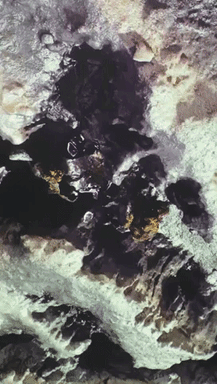Local, international artists turn Karachi into a technological canvas
- Two-week long third Karachi Biennale opened on Monday
KARACHI: Putting technology at the forefront, the third iteration of the Karachi Biennale (KB) opened across 9 venues to the general public on Monday. The biennale will run for two weeks until November 13.
This year, local and international artists have come together to produce works under the theme, ‘Collective Imagination: Now and the Next’ focusing mainly on the convergence between art and technology.
Speaking about some of the exhibits, Nilofer Farrukh, CEO of Karachi Biennale, told Business Recorder about how each work brings its own fascination, and that each piece incorporates different mediums and technologies in order to explore general issues within the environment.
“The exploration is very tentative,” said Farrukh. “Most Pakistani artists here do not have access to this field of study as art schools are just coming up with their new media departments. A biennale like this stimulates growth at home where artists and audiences get first-hand exposure as consumers of technology and get to be innovators.”

The artists, who specifically work with technologies such as Augmented Reality (AR) and the likes, were shortlisted by the curator Faisal Anwar.
Indeed this was evident in several pieces.
At the Mahvash & Jahangir Siddiqui Art Gallery located at the Alliance Francaise Karachi, Austrian artist Herwig Scherabon, in a work titled ‘Remembering You The City of Lights,’ displayed a diptych video installation showing the old ruins of Bhambore (1st Century BCE) and the landfill at Jam Chakro at the edge of Karachi.
Against a heady city soundtrack consisting of traffic noise and more, he explored ecology in an aesthetic manner, through imagery, movement and sound.

With eyes on digital art, 3rd Karachi Biennale set to begin October 31
Of this exploration, Farrukh elaborated how when international artists are approached to work in Karachi, they are fascinated and excited.
“Karachi is portrayed as full of contradictions. Outside of the lens of the media, artists are eager to come and experience the space for themselves. It is only when they arrive and immerse themselves in the city and the people is when they realise it is entirely different from their perceptions.”
The current biennale also looks to bridge the gap between the past and present and future.
“For example it is fascinating to see UK-based sound artists use an ancient sound instrument from Sindh within one such installation,” Farrukh stated.
With focus on digital, ‘Art Dubai 2022’ concludes
She was referring to a collaboration by arts studio ‘Invisible Flock,’ representing the United Kingdom and Pakistan that brings together Faqir Zulfiqar, a Sindhi folk musician, and Allah Jurrio, a 90 year old potter based in Badin, who also happens to be one of the few known craftsmen who created the Borindo, an instrument that can be traced back 5,000 years.
Titled ‘Microtonal’, the work is an interactive, data-driven sound sculpture created from 200 borindos made by the duo in Badin, Sindh.
Many of the sites too that were chosen were also intended to bridge this gap.
"Because technology needs to be housed indoors, more so than needing 'wall space', the biennale needed sound space. Of course we needed white cubes and we had the gallery spaces for that but the works needed a spatial boundary of sorts, so that sounds from one installation do not overlap and disturb the other. Our dialogue is as much with the spaces, as with the artworks,” Farrukh told Business Recorder.
One of the sites hosting the biennale is a private vertical space, Hamid Market, a particularly unique piece of our history. Built over a hundred years ago, it has also not been open to the public at all, which makes the installation within truly a must-visit.
“The University of Engineering and Technology (NED), too is a historical site, as it has an old part, and of course is a large space.
“It was important to choose spaces that were indoor, accessible to people, with a wider outreach,” she emphasized.

Along with that, heritage sites such as those along MA Jinnah road – Jamshed Memorial Hall, Denso Hall – are all are also situated in densely populated areas that encourage crowds to visit, which will encourage people along with their friends and families to visit.
She took us through Yasir Darya’s work titled, ‘Air Rider’ about pollution in Karachi, which is gathered through motorbikes placed at strategic geographic routes throughout the city, and displays them, area by area, for audiences, in real time.
His work allowed audiences to interact with the artwork and becomes a tool for usability also.
Artist Adeel uz Zafar opens up about current art trends, NFTs
At the Indus Valley School of Art and Architecture (IVSAA), Swiss artist Marc Lee in the aptly titled ‘Echolocation’ displayed social media in real time you make your way across a map. The work is a social commentary as much as a news aggregator, informing and commenting at the same time.
Eminent UK-based artist Shezad Dawood, explores the future, in a Virtual Reality (VR) work titled ‘The Terrarium.’ Housed at the Alliance Francaise, the work takes us 300 years in the future.
Asma Arshad Mahmood, a Canadian/Pakistani visual artist and curator and a member of the jury, termed the works this year as excellent, and at par with international art events.
Farrukh said she hoped the biennale would lead to the realisation of a contemporary art museum in Pakistan.
“There exists no cohesive space within which to house and view artworks that are crafted for events such as the biennale. Oftentimes we have paid for the commissioned pieces, and at the end of a biennale as such, they have to be returned to the respective artists, lacking a space to display them. They need to be part of a permanent exhibit.”





















Comments
Comments are closed.